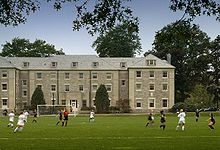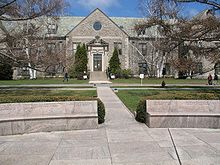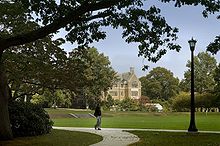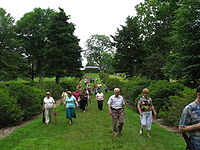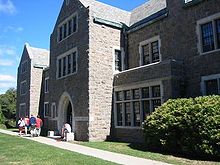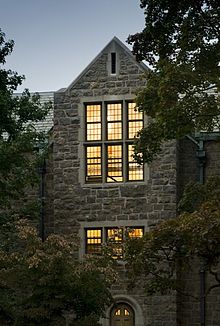- Connecticut College
-
This article is about the private institution in New London, Connecticut. For the public university in Storrs, Connecticut, see University of Connecticut.
Connecticut College 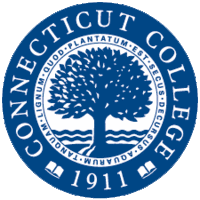
Motto Tanquam lignum quod plantatum est secus decursus aquarum "Like a tree planted by rivers of water" (that bringeth forth its fruit in its season.) (Psalm 1:3) Established April 1911 Type Private Endowment US$190 million (FY 2010)[1] President Leo I. Higdon, Jr. Academic staff 177 full-time Admin. staff 486 full-time Undergraduates 1,911 (1,839 full-time) Postgraduates 5 (4 full-time) Location New London, Connecticut, USA Campus Suburban Colors Blue and White Athletics NCAA Division III Sports 28 varsity teams,[2] 12 club teams Nickname Conn, Conn College Mascot Camel Affiliations NESCAC, CWPA Website conncoll.edu 
Coordinates: 41°22′42.36″N 72°06′16.81″W / 41.3784333°N 72.1046694°W
Connecticut College (Conn College or Conn) is a private liberal arts college located in New London, Connecticut.
The college was founded in 1911, as Connecticut College for Women, in response to Wesleyan University closing its doors to women (the college changed its name to Connecticut College in 1969 when it began admitting men). The campus is located on the Thames River, overlooking the Long Island Sound on the highest point in New London. It is a member of the New England Small College Athletic Conference (NESCAC), and is considered to be among the group of colleges called the "Little Ivies." Forbes ranked Connecticut College 62 in its America's Best Colleges list in 2011[3] and U.S. News and World Report ranked the school in its top forty liberal arts colleges in 2011.[4]
Known for its interdisciplinary academic centers,[5] Connecticut College is in the midst of a major fundraising and building campaign. Over the past several years the college has renovated many of its older dormitories, completed numerous classroom renovations, and constructed a new fitness center. The college is in the final planning stages of a new life science and computer science center, an international commons, and is continuing to renovate the remainder of its older dormitories and classroom spaces.
Connecticut College's fourth strategic plan (2004) introduced the College's new mission statement: "Connecticut College educates students to put the liberal arts into action as citizens in a global society."[6]
According to CNN Money, Connecticut College was the most expensive college in the United States in 2010 with a tuition fee of $43,990 and total cost of $53,110.[7] According to U.S. News and World Report, Connecticut College was the most expensive college in 2011 with $43,990 for tuition and required fees.[8] The college states that the comprehensive fee for 2011-12 is $54,970 [9]. At the same time, the college points out, "If you qualify for financial aid, you and your family could pay less than you might at a school with much lower tuition and fees." To this point, the average grant award (financial aid that a student does not have to pay back) at Connecticut College is about $30,390. Furthermore, 48% of enrolled Connecticut College students receive aid (totaling more than $28.9 million in financial aid awarded in 2010-2011), with 85% of the financial aid budget in the form of grants. Overall, the average financial aid award is $32,708.[10]
Contents
History and overview
Chartered in 1911, the founding of the college was a response to Wesleyan University's decision to stop admitting women.[11][12] Female Wesleyan alumnae, notably Elizabeth C. Wright, convinced others to found this new college, espousing the increasing desire amongst women for higher education.[13][14] Several large gifts of land gave the college its hilltop location overlooking Long Island Sound. Financial assistance from the city of New London, its residents, and a number of wealthy benefactors gave the college its initial endowment. According to an Oct. 12, 1935 article in the Hartford Daily Times, marking the College's 20th anniversary:
"On September 27, 1915, on this beautiful site, the college opened its doors to students. The entering class was made up of 99 freshmen students, candidates for degrees, and 52 special students, a total registration of 151. A fine faculty of 23 members had been engaged and a library of 6,000 volumes had been gathered together. It was an auspicious start for this new undertaking."
Connecticut College has been continuously accredited since 1932 by the New England Association of Schools and Colleges. In a typical year, the College enrolls about 1,900 men and women from 40-45 states, Washington D.C., and 70 countries. Approximately forty percent of students are men. The College is now particularly known for interdisciplinary studies, international programs and study abroad, funded internships, student-faculty research, service learning, and shared governance. Under the College's system of shared governance, faculty, staff, students, and administrators are represented on the major committees that make policy regarding the curriculum, the budget, and the campus and facilities.
Students live under the College's 84-year-old student-adjudicated Honor Code and without a Greek system. The Honor Code, which distinguishes Connecticut College from its peers, underpins all academic and social interactions at the College and creates a palpable spirit of trust and cooperation between students and faculty. Other manifestations of the Code include self-scheduled, unproctored final exams.
According to The Princeton Review 2005 and Campus Compact, Connecticut College is one of the nation’s best colleges for fostering social responsibility and public service. A January 2006 ranking noted that Connecticut College is among the 25 top small colleges in terms of the number of graduates who serve in the Peace Corps.
Connecticut College is a member of Phi Beta Kappa, the Annapolis Group, and the New England Small College Athletic Conference (NESCAC).
A reciprocal exchange agreement with the United States Coast Guard, allows cadets from the nearby USCG Academy to take some courses at the college, while Connecticut College students may take courses at the Academy.
Statistics
- Connecticut College is a member of a small group of institutions labeled the "Little Ivies"
- The College received an all-time high 5,301 applications for the Class of 2014 (the entering fall 2010 class). 31% of these applicants were accepted with a combined SAT score mean of 1280-1450 out of 1600 (650-740 in Reading and 630-710 in Math),[15] and 30% enrolled.
- In "America's Best Colleges 2010" published by U.S. News and World Report, Connecticut College was ranked 42nd out of 266 national liberal arts colleges. In subcategories, the College was ranked No. 28 for graduation and retention rates, No. 41 for financial resources, and No. 55 for admission selectivity. In the category of Best Undergraduate Teaching at Liberal Arts Colleges it ranked No. 17 equal. These figures represent a significant decline in the college's traditional ranking within the top 25 liberal arts colleges in the country in the 1990s and early 2000s.[16] In Washington Monthly's 2009 rankings, Connecticut College ranked 50 out of 253 liberal arts colleges.[17]
- Connecticut College had 171 full-time professors in Academic Year 2007-08; 90 percent hold a doctorate or equivalent. All classes are taught by professors. The student-faculty ratio is below 10:1.
- For the 2007-08 academic year, domestic students of color accounted for about 13.0% of all full-time and part-time students. International students accounted for about another 4.4% of the student body. The countries from which the most international students come are Turkey, China, Bulgaria, Germany, and India.
Academics
The College offers more than 1,000 courses in 29 academic departments and 7 interdisciplinary programs, and students can choose from 54 traditional majors plus opportunities for self-designed courses of study. The 10 most common majors over the last five years have been English, Economics, Psychology, Government, History, Biological Sciences, International Relations, Anthropology, Human Development, and Art. About 30% of Connecticut College students graduate with double majors. The most common double-major combinations are Government/History, Economics/International Relations, and Economics/Government, but graduates in recent years have also chosen interdisciplinary combinations such as Art/Computer Science, Film Studies/Latin American Studies, Biological Sciences and Religious Studies, and Art History/Italian.
Admission to the college is selective.[18][19] There were 4,733 applications for admission in 2008: 1,732 were admitted (36.6%) and 500 matriculated (28.9%).[20]
The College's First-Year Seminar Program provides student-faculty engagement in a small, intellectually stimulating setting in their first semester.
Connecticut College has four Interdisciplinary Centers that administer certificate programs, plus a fifth center that facilitates the teaching and researching of race and ethnicity across the curriculum. If accepted into one of the College's four certificate programs, students of any major complete a self-designed series of courses that relate to their academic interest, complete a College-funded summer internship, and complete an integrative project in their senior year. These four centers routinely attract the College's best students and are a model for the kinds of integrated educational pathways the College offers its students.
- Ammerman Center for Arts and Technology (CAT) Through the Ammerman Center, faculty and students can shape the study, use and creation of new technologies, probe the forefront of their fields and work in new markets with innovative products.
- Toor Cummings Center for International Studies and the Liberal Arts (CISLA) The CISLA mission is to encourage students to become public intellectuals: those who are politically concerned, socially engaged, and culturally sensitive and informed. CISLA prepares them to internationalize their majors and become responsible citizens in a global community.
- Holleran Center for Community Action and Public Policy (PICA) The Holleran Center orchestrates College and community resources to build on assets, respond to needs, and facilitate community revitalization and problem solving.
- Goodwin-Niering Center for Conservation Biology and Environmental Studies (CCBES) The Goodwin-Niering Center is a comprehensive, interdisciplinary program that builds on one of the nation's leading undergraduate environmental studies programs. The Center fosters research, education, and curriculum development aimed at understanding contemporary ecological challenges. The Center is named in honor of Richard H. Goodwin, Katharine Blunt Professor Emeritus of Botany, and William A. Niering, Lucretia L. Allyn Professor Emeritus of Botany. Professor Goodwin was among the early leaders of the Nature Conservancy, serving as its president from 1956–58 and 1964-66.
- Students can earn Connecticut teacher certification and certificates in the College's Museum Studies program.
- Between 50 and 55% of the student body studies abroad at some point during their four years. Connecticut College offers several ways for students to study abroad, including traditional study away programs, semester-long Study Away, Teach Away (SATA) programs, and shorter Traveling Research and Immersion Programs (TRIPs) that are typically related to specific courses.
- The Eugene O'Neill Theater Center's National Theater Institute confers course credit through Connecticut College. Students often intern and partake in semester study-away programs at the institute.
- Many opportunities for conventional study abroad are available, as well as the special programs CISLA (one of the academic centers), which allows students to "internationalize" their major, and SATA (Study Away Teach Away), in which a Connecticut College professor takes a small group of students for a semester to a country that the professor has experience with, and there the students take classes at a local university, and one with the Conn professor.
- Students' classroom learning at Connecticut College is supplemented by a wide variety of service learning courses and volunteer work in the New London area. Many of these opportunities are coordinated by the Office of Volunteers for Community Service. OVCS facilitates student involvement in the community by running a van shuttle service, which transports students to and from sites in the area.
- Connecticut College has a history of undergraduate research work and students are encouraged to make conference presentations and publish their work under the guidance of a professor.
- Connecticut College graduating seniors are regularly awarded prestigious fellowships and grants such as the U.S. Student Fulbright Program grant. In 2008, five Connecticut College graduates received Fulbright grants.[citation needed]
Campus and facilities
The main campus has three residential areas. North Campus contains the newest residential halls (Morrisson, Wright, Lambdin, Park, Johnson—formerly Marshall—and Hamilton, collectively known as "The Plex"), all of which are connected to each other and Harris Dining Hall. South Campus contains residence halls along the side of Tempel Green (Harkness, Addams, Freeman, and Knowlton), across from several academic buildings. Central Campus contains the oldest residence halls (Windham, Warnshuis, Burdick, Smith, Larrabee, Plant, Branford, Blackstone, Blunt, and Lazrus) and is the closest to the student center and the library. Students also have several less traditional housing options, including the 360 Apartments, River Ridge Apartments, Earth House, and Abbey House. A few students also live off-campus in New London or Waterford.
The College's science facilities include a rooftop observatory, lab for NMR spectroscopy, a digital transmission electron microscope, a scanning electron microscope, a greenhouse, a channel flow laboratory, a GIS lab, and a 1 MeV Pelletron ion accelerator. Its computer facilities include standard UNIX and PC labs as well as specialized labs in robotics, networks, virtual reality and digital signal processing. The robotics lab is equipped with Sun workstations, PCs, robots, and overhead cameras. The virtual reality and signal processing lab (which is also part of the Ammerman Center for Arts and Technology) has high-end graphics PCs, head-mounted displays, 3-D trackers, force feedback devices, spatialized audio devices, and software for producing high-end animations and graphics.
The departments of the fine arts are located in three places around campus. The Cummings Arts Center contains two concert halls, the Center for Electronic and Digital Sound, pianos, practice rooms, a pipe organ. The Art and Music departments and their classrooms and studios are also housed in Cummings. Surrounding the Arts Center are numerous sculptures, especially in the courtyard known as Castle Court. This lies between Cummings and the largest of the College's performance spaces, Palmer Auditorium. The Theater department has offices in Palmer, and has classes on the main stage, in a smaller classroom in Palmer, and in Tansill Theater, which is further north, near the main entrance. The Dance department is housed on the third floor of the student center, and includes 3 dance studios.
There are three libraries on the campus. Shain Library houses a collection of more than 500,000 books and bound periodicals, along with an extensive collection of microforms, computer files, audio and video tapes. The library is also home to the Charles Chu Asian Art Reading Room, a space used for studying, public lectures, and receptions. In 2004, the "Blue Camel Cafe" opened in the library basement, selling coffee, tea, pastries and other items to studying and socializing students. The Greer Music Library in Cummings Arts Center holds books and periodicals about music and musicians, printed music, and numerous recordings on cassette, CD, and vinyl, as well as digital media. The chapel library, in the basement of Harkness Chapel includes volumes and periodicals related to religious studies and social justice.
- The Connecticut College Arboretum is a 750 acre (3 km²) arboretum and botanical garden. Students frequently go to the Arboretum to walk, study, or otherwise enjoy nature. The Arboretum is also open to the community, and its staff host frequent workshops, guided hikes, and other interpretive activities.
- Harkness Chapel is a fine example of noted architect James Gamble Rogers' colonial Georgian style, with twelve stained glass windows by G. Owen Bonawit. The building is used for several denominational religious services each week, as well as for ceremonies, concerts and recitals, weddings, and other public functions.
- The College has a variety of indoor and outdoor athletic facilities, including a new fitness center that opened in fall 2009.
- The Lyman Allyn Art Museum[21] is located on campus, although it is not connected to the campus proper. The museum's web site describes it as follows: "Housed in a handsome Neo-Classical building designed by Charles A. Platt, the permanent collection includes over 10,000 paintings, sculpture, drawings, prints, furniture and decorative arts, with an emphasis on American art from the 18th through 20th centuries."
Student life
- The Honor Code is signed by all students upon matriculation. It allows a strong student voice in shared governance through the Student Government Association, and the luxury of self-scheduled, unproctored exams. Because of the Honor Code, students are treated by faculty, staff, and the administration as mature adults. A student-run Judicial Board adjudicates alleged infractions of the Honor Code.
- Through a gift by an alumnus, Connecticut College students may take music lessons during the semester at no charge.
- Connecticut College has seven a cappella groups: three women's groups (the ConnChords, The Shwiffs and Miss Connduct), one men's group (Co Co Beaux), and three coed groups (Conn Artists, Vox Cameli, and Williams Street Mix).
- WCNI (90.9 FM), the college radio station, broadcasts a variety of music including polka, blues, and celtic music shows. A 2,000 watt transmitter installed in 2003 reaches much of Connecticut, parts of Rhode Island, and parts of southwest Massachusetts.
- The College Voice, Connecticut College's only student newspaper, is an editorially independent print and online publication. Students print weekly, and handle all aspects of production: reporting, editing, ad sales, management, photography, layout, multimedia and design. They also run a variety of guides and blogs, like the New London local dining guide and the summer student intern blog The Summer Voice.
Connecticut College in film and culture
- Connecticut College was mentioned on the television program The Office (in the episode "Night Out") Rainn Wilson's character wishes the Jersey State women's basketball team luck in a game against Connecticut College. One of the show's writers, Lee Eisenberg, is a Conn College graduate.
- In the AMC series Mad Men (in the episode "Red in the Face"), Pete Campbell's friend says "Connecticut College for Women, indeed..." in reference to Pete's attractive cousin.
- The protagonist in the film The Visitor is a fictional Connecticut College economics professor.
- In The Widows of Eastwick by John Updike, a character remembers "when after my mother died my father sent me east to Connecticut College for Women, everything so lush and old."[22]
- In the sitcom series Kate & Allie, both women had gone to Connecticut College and sometimes wore a Conn College sweatshirt.
- The opening scenes of the 1966 film The Group (featuring Candice Bergen), were filmed at Connecticut College. The film is based on a book about a private women's college.
Programs and offices
- Student Activities Council (SAC) The Student Activities Council hosts a series of weekly concerts, Friday Nights Live, with performances by on-campus and off-campus bands. Some of the recent FNL acts include: Jon McLaughlin, Paranoid Social Club, Land of Talk, Langhorne Slim, Locksley, Stephen Kellogg, Girlyman, Winterpills, and Ari Hest. The Student Activities Council is also responsible for the spring concert, Floralia, (recent acts have included: Girl Talk, 1997 (band), The Misshapes, okgo, and Reel Big Fish), the Fall Concert (recent acts include RJD2, Blackalicious, and Ben Lee). In addition to Friday Nights Liv and other concerts, the Student Activities Council is responsible for planning dances, study breaks, and small events on campus. SAC is also responsible for the annual Harvestfest (an event during Alumni Weekend where student groups can sell merchandise for fundraising).
- Floralia The annual spring concert festival on the library green, with musical performances and socializing. See Floralia.
- Career Enhancing Life Skills (CELS) is a four-year program through which students explore career options, assess interests and skills, learn to consider lifetime goals when planning coursework and activities, look for a career-related junior-year internship, and get help with a job search as seniors.
- Unity House is the college's multicultural center. Unity House promotes, supports, educates, and implements multicultural awareness programs on campus. It also houses a library and group meeting room, open to all. It also hosts many intercultural organizations, including but not limited to Umoja (African Diaspora club), and CCASA (Connecticut College Asian/Asian American Student Association).
- The LGBTQ Resource Center serves the needs of Lesbian, Gay, Bisexual, Transgender, Queer, Questioning, Intersex, and Ally students by providing a supportive space, resource library, social events, and educational programming. The Center also serves as a resource for the entire College Community to learn about issues related to sexuality and gender identity. It hosts the student organizations Spectrum (formally SOUL), Connecticut College Queer and Questioning (CQ^2), and the Campaign for Gender Identity Awareness (CGIA).
- Office of Volunteers for Community Service (OVCS) helps students find volunteering opportunities in the community. Also provides a student-staffed van service to drive students to their community service.
Notable alumni
Main article: List of Connecticut College AlumniConnecticut College graduates of note include The Atlantic senior editor Joshua Green, AOL CEO Tim Armstrong (executive), New York Times best-selling authors Sloane Crosley and David Grann, fashion designer Peter Som, philanthropist Nan Kempner.
Campus publications
- CONNtact (newsletter)
- Friends of CC Library
- Inside Information
- Source (faculty/staff newsletter)
- The College Voice (student-run newspaper distributed at the student center, library, academic buildings, residential houses, and to off-campus subscribers)
- Koiné (yearbook)
- Expose (interdisciplinary academic journal)
- Underexposed (black-and-white photography magazine)
- The Sound (literary and art magazine)
Connecticut College presidents
- 1913-1917: Frederick H. Sykes
- 1917-1928: Benjamin T. Marshall
- 1929-1943: Katharine Blunt
- 1943-1945: Dorothy Schaffter
- 1945-1946: Katharine Blunt
- 1947-1962: Rosemary Park
- 1962-1974: Charles E. Shain
- 1974-1988: Oakes Ames
- 1988-2001: Claire L. Gaudiani
- 2001-2006: Norman Fainstein
- 7/1/2006- : Leo I. Higdon, Jr.
References
- ^ As of June 30, 2010. "The College Sustainability Report Card" (URL). Report Card 2011. Sustainable Endowments Institute. p. 1. http://www.greenreportcard.org/report-card-2011/schools/connecticut-college. Retrieved January 19, 2011.
- ^ "Connecticut College: Athletics". Connecticut College. Conncoll.edu. Accessed 30 January 2010.
- ^ "#83 Connecticut College". Forbes. 2010-08-11. http://www.forbes.com/colleges/connecticut-college/.
- ^ "Liberal Arts Rankings: Best Colleges". U.S. News and World Report. Usnews.com. 08-19-11. Accessed 10-05-11.
- ^ "Connecticut College". BrainTrack. Braintrack.com. Accessed 21 March 2010.
- ^ "Connecticut College: About Connecticut College - Mission". Connecticut College. Conncoll.edu. Accessed 30 January 2010.
- ^ "Most expensive colleges". CNN Money. money.cnn.com. Accessed 1 August 2011.
- ^ "10 Most Expensive Private Colleges" U.S.News & World Report. usnews.com Accessed 11 November 2011.
- ^ "Connecticut College Admissions - Tuition & Fees". Connecticut College. conncoll.edu. Accessed 11 November 2011.
- ^ "Connecticut College Financial Aid". Connecticut College. conncoll.edu. Accessed 11 November 2011.
- ^ "History of Wesleyan - About - Wesleyan University". Wesleyan.edu. http://www.wesleyan.edu/about/uhistory.html. Retrieved 2011-06-16.
- ^ "Connecticut College : News : Centennial video generates excitement". Conncoll.edu. 2011-01-19. http://www.conncoll.edu/news/6749.cfm. Retrieved 2011-06-16.
- ^ "Connecticut College : Centennial News : A History of Connecticut College: New London Raises $100,000". Conncoll.edu. http://www.conncoll.edu/news/6822.cfm?var1=centennial. Retrieved 2011-06-16.
- ^ "Connecticut College : Centennial News : The founding of Connecticut College". Conncoll.edu. 2011-01-05. http://www.conncoll.edu/news/6707.cfm?var1=centennial. Retrieved 2011-06-16.
- ^ Connecticut College : Admission - Admission Statistics[dead link]
- ^ "Best Colleges | Find the Best College for You | US News Education". Colleges.usnews.rankingsandreviews.com. 2011-01-31. http://colleges.usnews.rankingsandreviews.com/best-colleges. Retrieved 2011-06-16.
- ^ "Washington Monthly rankings". 2007. http://www.washingtonmonthly.com/college_guide/rankings/liberal_arts_rank.php. Retrieved 2009-10-05.
- ^ Carnegie Foundation for the Advancement of Teaching. "Carnegie Classification". http://carnegiefoundation.org/classifications/sub.asp?key=748&subkey=13745&start=782. Retrieved 2008-09-07.
- ^ US News & World Report. "US News & World Report Best Colleges 2009". http://colleges.usnews.rankingsandreviews.com/college/items/1379. Retrieved 2008-09-07.
- ^ "Admissions Statistics". Office of Admissions, Connecticut College. http://www.conncoll.edu/admission/4305.htm. Retrieved 2009-08-03.
- ^ "Lyman Allyn Art Museum, New London, Connecticut". Lymanallyn.org. http://www.lymanallyn.org/index.htm. Retrieved 2011-06-16.
- ^ The Widows of Eastwick (2008) via Google Books.
External links
New England Small College Athletic Conference Colleges and universities in Connecticut Public institutions Private institutions Albertus Magnus · Briarwood · Connecticut College · Fairfield · Goodwin · Holy Apostles · LACFA · Mitchell · Paier · Post · Quinnipiac · Rensselaer at Hartford · Sacred Heart · Saint Joseph · Trinity · University of Bridgeport · University of Hartford · University of New Haven · Wesleyan · Yale
Federal institutions Community Colleges Graduate, professional, and
research institutionsBerkeley Divinity School · Hartford Seminary · Quinnipiac School of Law · University of Connecticut Health Center · University of Connecticut School of Dental Medicine · University of Connecticut School of Law · Yale Law School · Yale School of Drama · Yale School of Medicine
Annapolis Group Chair Member schools Agnes Scott • Albion • Albright • Allegheny • Alma • Amherst • Augustana • Austin • Bard • Barnard • Bates • Bennington • Berea • Berry • Birmingham-Southern • Bowdoin • Bryn Mawr • Bucknell • Carleton • Centre • Chatham • Claremont McKenna • Coe • Colby • Colgate • Saint Benedict • Colorado • Connecticut • Cornell • Davidson • Denison • DePauw • Dickinson • Drew • Earlham • Eckerd • Franklin & Marshall • Furman • Gettysburg • Gordon • Goucher • Grinnell • Gustavus Adolphus • Hamilton • Hampden-Sydney • Hampshire • Harvey Mudd • Haverford • Hendrix • Hiram • Hobart & William Smith • Hollins • Holy Cross • Hope • Illinois Wesleyan • Juniata • Kalamazoo • Kenyon • Knox • Lafayette • Lake Forest • Lawrence • Lewis & Clark • Luther • Macalester • Manhattan • McDaniel • Middlebury • Millsaps • Monmouth • Moravian • Morehouse • Mount Holyoke • Muhlenberg • Nebraska Wesleyan • Oberlin • Occidental • Oglethorpe • Ohio Wesleyan • Pitzer • Pomona • Presbyterian • Puget Sound • Randolph-Macon • Randolph • Reed • Rhodes • Ripon • Rollins • St. Benedict and St. John's • St. John's • St. Lawrence • St. Olaf • Salem • Sarah Lawrence • Scripps • Sewanee • Skidmore • Smith • Southwestern • Spelman • Swarthmore • Sweet Briar • Transylvania • Trinity College • Trinity University • Union • Ursinus • Vassar • Wabash • Washington • Washington & Jefferson • Washington & Lee • Wellesley • Wesleyan College • Wesleyan University • Westmont • Wheaton • Whitman • Whittier • Willamette • William Jewell • Williams • Wittenberg • WoosterConsortium of Liberal Arts Colleges (CLAC) Albion · Alma · Amherst · Bates · Beloit · Bowdoin · Bryn Mawr · Bucknell · Carleton · Colby · Colgate · Colorado College · Connecticut College · Davidson · Denison · DePauw · Dickinson · Earlham · Eckerd · Franklin & Marshall · Gettysburg · Grinnell · Hamilton · Harvey Mudd · Haverford · Holy Cross · Hope · Kalamazoo · Kenyon · Lafayette · Lawrence · Lewis & Clark · Luther · Macalester · Manhattan · Middlebury · Mills · Mount Holyoke · Muhlenberg · Nebraksa Wesleyan · Oberlin · Occidental · Ohio Wesleyan · Pitzer · Pomona · Reed · Rhodes · Scripps · Sewanee · Skidmore · Smith · St. Lawrence · St. Olaf · Swarthmore · Sweet Briar · Trinity (CT) · Trinity (TX) · Union · Vassar · Wabash · Washington · Washington & Lee · Wellesley · Wesleyan · Westmont · Wheaton (IL) · Wheaton (MA) · Whitman · Whittier · Williams · Wooster
Categories:- Connecticut College
- Liberal arts colleges
- Universities and colleges in Connecticut
- New England Small College Athletic Conference
- New London, Connecticut
- Former women's universities and colleges in the United States
- Educational institutions established in 1911
- Council of Independent Colleges
- National Association of Independent Colleges and Universities members
- New England Association of Schools and Colleges
- Universities and colleges in New London County, Connecticut
- Members of the Annapolis Group
Wikimedia Foundation. 2010.


